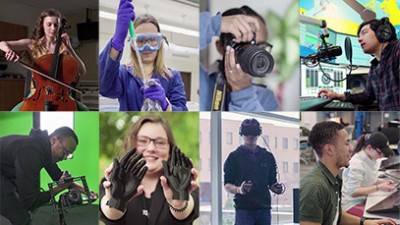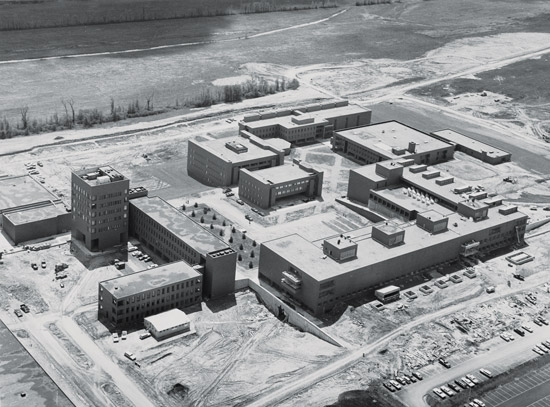Forty years on the new campus
Remembering how it all began
An aerial view of the campus as construction neared completion in 1968. (Photo courtesy RIT Archives)
Travel back in time to 1968. It is an awesome, yet awful year:
Rowan and Martin’s Laugh-in TV series debuts.
Martin Luther King Jr. is slain in April followed by Robert F. Kennedy’s assassination in June.
Hair opens on Broadway.
North Vietnam’s brutal Tet Offensive marks a watershed in the war in Vietnam.
The Beatles release The White Album.
Richard Nixon is elected president, defeating Hubert Humphrey.
Movie audiences watch The Graduate, 2001: A Space Odyssey, Guess Who’s Coming to Dinner?, Barbarella and Planet of the Apes.
Apollo 8 astronauts circle the moon.
RIT’s new $60 million campus opens on a 1,300-acre site in the Rochester suburb of Henrietta.
“It is a time when much of great significance has been achieved,” President Mark Ellingson wrote in Reporter’s summer 1968 edition. “It is also the time when everything that we have anticipated confronts us. At no time in the history of the institute has the opportunity for personal and professional development been greater.”
The feeling of anticipation was somewhat stifled by what confronted students on their arrival that September.
“It was muddy and barren,” recalls Grant Hamilton ’69 (printing), who was editor and general manager of Reporter, the student newspaper. “The 1960s campus architecture was a shock to the system. It was quite a contrast to the atmosphere of the downtown campus.”
That seems to be the general consensus. “It was like little nothing out there,” says Allison Adams-Weinberg ’70 (hospitality and service management).
“It was a big swamp,” says Thomas Barker ’65, ’70 (imaging science, statistics).
“The wind used to whistle through there like Russian Siberia,” says Jerry Infantino ’69 (art and design). “But RIT had to grow, and there was no room downtown.”
In fact, a large portion of the downtown campus – 11 buildings – had been slated for demolition to make way for Rochester’s Inner Loop expressway. Announcement of that project by the state Department of Transportation in 1959 motivated RIT’s leaders to consider relocating the campus. A surprise $3.27 million bequest from Grace Watson in 1961 helped put such a plan within reach, and in November 1961, after lengthy discussions, the Board of Trustees voted to build a new campus. All 35 members were present; only two voted nay, and one abstained.
Plans for the campus were unveiled with appropriate fanfare under a tent on the Henrietta site – formerly farmland – in September 1963 and construction began in 1964. Five architectural firms, each highly regarded for modernist design, worked on different parts of the project but collaborated to create a homogeneous whole. Over the next few years, members of the RIT community trekked to the site periodically to watch the progress.
“I remember arriving at school one day and finding out it was ‘new campus day,’ ” says Barker. “We all went out to the swamp. I think we were excited about what was to come. Some of the old buildings were getting pretty rickety.”
By early 1967, it appeared that the new campus would be ready for operation that fall. Construction delays made that impossible, so opening day was put off for a year.
Even so, all was far from perfection when classes began Sept. 19, 1968.
“The campus was not complete, paths were not all built, and there was a lot of mud,” writes Dane R. Gordon, professor emeritus, in Rochester Institute of Technology: Industrial Development and Educational Innovation in an American City 1829-2006 (RIT Press, 2007). “Not all of the equipment was installed; some of it was there in parts but not assembled. This made instruction and labs difficult. One day about 200 students gathered around the sundial to protest conditions and demand a tuition refund.”
Reporter actually printed some editions with blank pages to protest the lack of adequate space. Hamilton says they expected to have use of new facilities in the Department of Printing. Instead, Reporter was relegated to a 10-by-13-foot office. Eventually, the dispute was resolved and Reporter moved into space in the basement level of the Student Alumni Union – which remains the publication’s headquarters. (Today, the weekly magazine-format Reporter is printed in RIT’s Printing Applications Laboratory.)
Eventually, all the pieces were in place and the campus community began to appreciate the new facilities. Adams-Weinberg, a member of Alpha Xi Delta, says sorority members were pleased with their new quarters. Hamilton says the sports facilities were better, and the arrival of NTID students added a dimension to campus life.
The newly planted trees grew, softening the lines of the architecture, which – despite early criticism – won the Collaborative Achievement in Architecture Medal from the American Institute of Architects in 1972. Structures added since 1968 have, in the main, continued the brick theme, while additional landscaping has provided substantial eye appeal – and shelter from the wind.
Barker, who worked for Xerox and later became a faculty member in the Kate Gleason College of Engineering, believes that the opening of the new campus was an important component of RIT’s evolution into a prestigious, nationally known university.
Jerry Infantino agrees. “It was exciting to be a part of the new experience,” he says. “RIT was coming into its own.”








